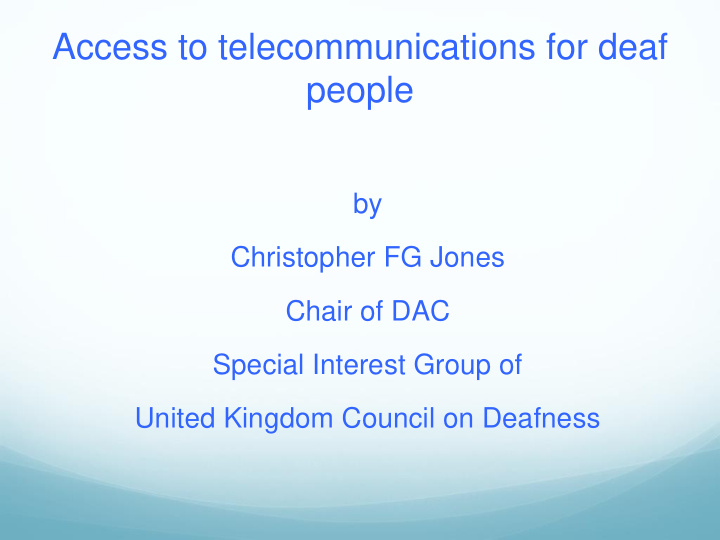



Access to telecommunications for deaf people by Christopher FG Jones Chair of DAC Special Interest Group of United Kingdom Council on Deafness
What are relay services? Relay services allow deaf people to communicate with hearing users (and vice versa) over the telecommunications network. A relay operator converts speech from the hearing caller to text or sign on the deaf person’s display screen.
Relay Services in the UK The UK has ONE Next Generation Text Relay (NGTR), a limited SMS Relay and an even more limited Video Relay Service (VRS). Deaf people are an heterogeneous group. AoHL’s research states there are 900,000 people with severe or profound hearing loss (hearing loss >70 dB). Deaf and hard of hearing people need a range of relay services which meets their individual needs.
Next Generation Text Relay (NGTR) Under Communications Act 2003, Ofcom has a narrow remit to ensure the provision of a Text Relay. Their remit does not cover other types of relay services such as Video Relay (VRS) and Captioned Telephone Relay Service (CTRS). General Condition 15 stipulates that each CP must provide access to an approved Text Relay. This means they need to set up their own Text Relay or pay to provide their customers with access to one.
Next Generation Text Relay (NGTR) BT chose to provide an approved Text Relay – Next Generation Text Relay Other Communication Providers pay BT to access NGTR. There are major issues with the BT service : primarily setting up and accessing the service and the slow speed of transcription
Issues with Next Generation Text Relay Typical conversation speeds are between 150 to 220 w.p.m. NGTR is slow : KPI set by OFCOM is a floor of 40 wpm and a minimum average of 60wpm. Relay Assistants type at speeds of 60 to 80 wpm, so they frequently need to ask the hearing caller to stop or slow down so their typing can catch up with the speed of the speech. Frustrated hearing callers rarely return calls to deaf people via NGTR. NGTR is not a functional equivalent relay service compared to normal telephone calls.
Alternative Relay Services - CTRS Captioned Telephone Relay Service (CTRS) : the transcription speeds averages 155 wpm but can handle up to 220 wpm. This service provides the most functionally equivalent telephone call for both deaf and hearing people. Hearing callers are more likely to call deaf users using this type of relay service. This is for deaf people whose speech is understood by the hearing caller.
Case study A high flier who worked in a prestigious City finance company used CTRS On its closure, he resorted to using emails entirely to arrange face to face meetings with his clients. His clients would not accept calls via NGTS due to the speed of transcription and the number of interruptions His employer found this most dissatisfying and made him redundant
Alternative Relay Services - Video Relay Services Ed Vaizey’s letter to FTSE Top 100 companies – 11 subscribe to VRS Local Authorities in England & Wales – 16 subscribe to VRS A total of organisations including the above – 88 subscribe to VRS DWP is the only government department that has access to VRS. Results are poor after 6 years.
Video Relay Services The voluntary model for VRS is not working. Deaf people whose English skills are not strong cannot use VRS to access emergency services. They cannot make social calls to the friends and families or call to SMEs. VRS provides functionally equivalent telephone calls for BSL users.
Solution? Amend the clause in the Communication Act 2003 which stipulates that a text relay service should be provided by : Specifying the inclusion of a range of different types of relay services:- Text Relay Captioned Telephone Relay (CTRS) Video Relay Service (VRS) And other types of relay services.
Conclusion This solution would put UK in a similar situation to Australia, New Zealand and the USA It would enable deaf people to fully participate in society It would offer better employment and promotion prospects It would improve the mental well being of all, particularly elderly people as they would be better able to maintain contact with family and friends
How you can help Ask Ofcom to commission a review of relay service provision and whether it is meeting the test of functional equivalence. Ask DCMS what consideration it has given to expanding OFCOM’s remit to include the provision of Video Relay services and Captioned Telephone Relay.
How you can help Ask BT what it proposes to do to ensure the NGTR service meets the test of functional equivalence and to report back on its investigations into the use of Automated Speech Recognition and/or Captioned Telephone Relay. Ask BT how it intends to improve usability of NGTR on mobile phones and reach all those who could benefit from the service.
How you can help Costings Our Delphi Report April 2013 estimated the cost of VRS by 2024 based on April 2013 prices is £55M per year of which £22M will be used to access public services. For CTRS, the cost at 2024 could be £32M per year.
Recommend
More recommend